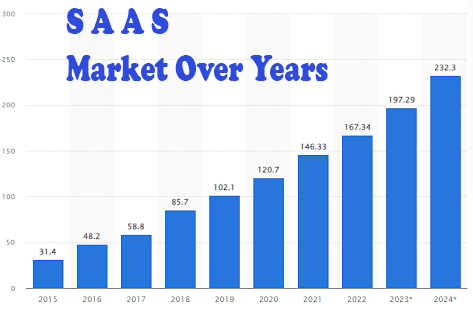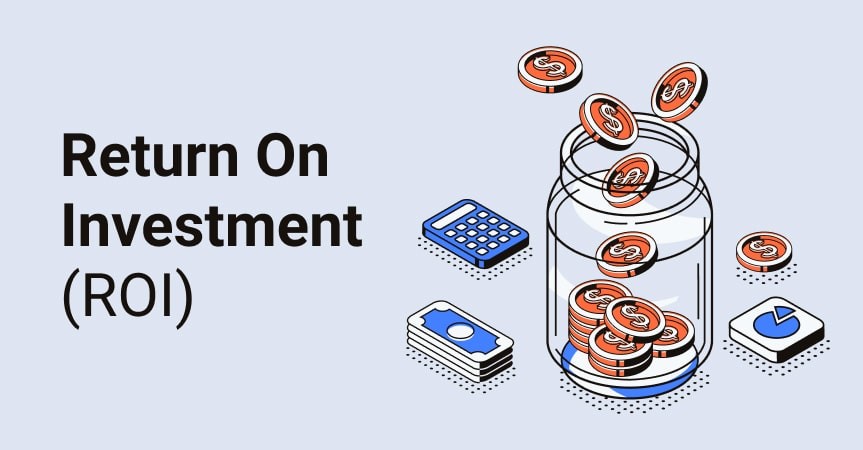Understanding the latest SaaS market trends can seem like an uphill battle, especially when you’re new to this rapidly evolving industry.
Browsing through tech forums, news sites, and LinkedIn posts might leave you feeling overwhelmed. You’ll find countless discussions about how SaaS is revolutionizing business operations globally.
“You can’t navigate the SaaS landscape without understanding its trends.” This simply isn’t true. There are plenty of resources available that provide comprehensive insights into these trends for both beginners and seasoned professionals alike.
The beauty of the SaaS industry lies in its constant evolution. Emerging startups and established companies continue to introduce innovative solutions that disrupt traditional business models – making knowledge on current SaaS market trends crucial for
The Growth and Consolidation of the SaaS Market
SaaS market trends: As we traverse a digital-oriented age, one area that is witnessing massive development is Software as a Service (SaaS). According to Fortune Business Insights, this market is projected to skyrocket up to $716.52 billion by 2028.
This rapid surge can be attributed largely to increased adoption rates across various industries.
In fact, around 80% of companies today are leveraging at least one SaaS application in their operations. These cloud-based solutions offer scalable services that drive business growth.
Vertical vs Horizontal SaaS
To fully comprehend the dynamics within this booming industry, it’s essential for us to distinguish between vertical and horizontal SaaS products.
A closer look reveals two distinct paths – Vertical SaaS caters specifically towards niche markets such as healthcare or financial services while horizontal SaaS serves wider functions applicable across multiple sectors like customer relationship management or human resources.
Fascinatingly enough, there has been an uptick in demand for more specialized tools leading toward an increase in popularity of vertical solutions with existing companies offering these seeing a rise by 28% from just last year alone.
SaaS Companies Acquiring Smaller Businesses
SaaS market trends: An intriguing trend accompanying this boom involves larger players acquiring smaller entities strategically aimed at expanding capabilities whilst gaining a competitive edge over rivals.
Larger firms benefit from integrating innovative features developed by startups into their broader offerings, thereby enhancing the overall value proposition without necessarily having to invest heavily in research and development themselves.
SaaS market is booming, projected to hit $716.52B by 2028. With 80% of companies using at least one SaaS app and a rise in demand for vertical solutions, the future looks bright. #SaaSTrends #DigitalTransformationClick to Tweet
Decoding Pricing Models in the SaaS Industry
The strategic selection of pricing models plays a pivotal role in driving business growth and profitability, especially within the burgeoning SaaS market. Several prevalent pricing strategies are shaping this landscape.
Navigating Usage-Based Pricing (UBP)
In recent years, usage-based pricing (UBP) has been increasingly adopted by leading companies operating within the SaaS industry. This model is particularly appealing as it allows businesses to align their revenue with actual customer consumption rather than relying on flat-rate subscription fees.
A staggering 45% of all SaaS providers had already implemented UBP into their strategy by 2023. Its popularity stems from its inherent fairness and scalability; customers pay solely for what they use which not only encourages greater engagement but also enables businesses to scale revenues alongside customer utilization rates.
This trend shows no signs of slowing down either – projections suggest that approximately 56% of all firms will have embraced UBP by 2023. You can delve deeper into understanding this growing phenomenon at Chargebee’s glossary.
Moving Towards Value-Based Pricing
Beyond UBP, another emerging trend gaining traction among both startups and larger enterprises alike is value-based pricing.
This approach revolves around setting prices based primarily on perceived or estimated client value instead of costs associated with production or prevailing market rates. It offers several competitive advantages including improved customer retention due to perceived fairness along with increased profit margins when successfully executed since price closely mirrors clients’ willingness-to-pay thresholds.
To gain more insights about how this innovative strategy works, check out Chargebee’s detailed guide on value-based pricing, an essential read if you’re considering adopting such a system for your own venture or simply want to understand why differentiation remains crucial in buying decisions across various markets today.
Key Takeaway:
In the SaaS industry, strategic pricing models like Usage-Based Pricing (UBP) and Value-Based Pricing are key drivers of growth. UBP’s fairness and scalability make it popular among providers, with projections showing its adoption rising to 56% by 2023. Meanwhile, value-based pricing leverages customer-perceived value for improved retention and profit margins.
Cloud Adoption and Its Impact on Business Operations
The business landscape is undergoing a significant transformation, with cloud services like Amazon Web Services (AWS) leading the charge. These platforms are becoming integral to modern business operations, driving efficiency and competitive advantage.
The shift towards cloud-based solutions is in full swing.
Increased Demand for Cloud-Based Solutions
A growing number of businesses are turning to cloud computing due to its scalability, cost-effectiveness, and flexibility. This increased demand has been noted across various industries worldwide.
Data from industry reports indicate that spending on public cloud services will see an impressive growth rate this year alone. The rapid digitalization brought about by recent global events has only accelerated this trend further as companies scramble to adapt their strategies around these technologies.
This isn’t just a phenomenon observed among large enterprises; small businesses too have jumped onto the bandwagon. With AWS or similar providers offering scalable resources at affordable rates, they’re now able to cater swiftly changing market demands without breaking the bank – something unheard of a few years back.
Efficacy of Cloud Computing in Streamlining Business Operations
Moving away from traditional data centers allows today’s savvy organizations not only to save costs but also to significantly improve operational efficiencies. For instance, Infrastructure as a Service (IaaS) enables them to quickly scale up or down depending on their needs, thereby avoiding hefty expenses associated with maintaining physical servers and locally stored databases.
By 2025, a Seagate Technology PLC report projects that cloud-based data storage will account for nearly half of all data worldwide. This massive shift represents an enormous opportunity for SaaS providers to offer analytics tools specifically designed to manage big data sets within this new environment. Beyond infrastructure considerations, though, lies perhaps the most compelling reason behind the widespread agility offered by such a platform – enabling faster response times when adapting to changes, whether those involve launching products/services or responding to sudden shifts in customer behavior patterns, thus providing a crucial edge over competitors still relying on traditional IT setups.
Key Takeaway:
Cloud adoption is no longer a trend, but a business necessity. With its scalability and cost-effectiveness, businesses of all sizes are hopping on the bandwagon. Not only does it save costs by eliminating physical servers, but also boosts operational efficiency and agility in responding to market changes – making it a game-changer in today’s digital landscape.
Understanding the Impact of AI Market Trends on the SaaS Industry
SaaS market trends: The combination of AI and SaaS is revolutionizing the way companies operate and vie for success. AI’s ability to analyze vast quantities of data, predict outcomes, automate tasks, and personalize user experiences brings transformative possibilities within reach.
It’s time to explore how these trends are shaping customer experience in the SaaS industry.
The Role that Artificial Intelligence Plays in Amplifying Customer Experience
A prominent trend surfacing within significant SaaS trends involves harnessing AI technology for enhancing customer experience. Machine learning algorithms coupled with predictive analytics enable companies to decipher patterns embedded in their customers’ behavior.
This insight facilitates personalized content or recommendations that resonate deeply with individual users – a strategy already adopted by leading companies across various specific industries including financial services and cloud platform providers like Amazon Web Services.
In addition, many SaaS applications have begun incorporating automated chatbots powered by natural language processing capabilities – an offshoot of AI technology – into their customer service operations. These bots can address common queries round-the-clock without human intervention, thereby improving response times while simultaneously freeing up valuable staff resources.
Gaining Competitive Edge through Integration of Artificial Intelligence
Beyond simply enhancing user satisfaction levels, integrating advanced artificial intelligence capabilities into business growth strategies can provide competitive advantages over those yet to adopt such technologies.
- Data-driven decision making: By leveraging machine learning algorithms for analyzing large volumes of data quickly and accurately, organizations gain insights enabling faster informed decisions.
- Predictive maintenance: Predictive analytics tools integrated with IoT devices connected via AWS or Google Cloud Platform could identify potential system failures well ahead, thus reducing downtime significantly.
- Tailored marketing strategies: Modern CRM systems employing machine learning models offer advanced segmentation techniques, helping firms create highly targeted marketing campaigns which boost conversion rates substantially.
Key Takeaway:
AI’s integration into SaaS is revolutionizing business operations, enhancing customer experiences and providing competitive advantages. By analyzing user behavior patterns, AI enables personalized content creation and efficient query handling via chatbots. Additionally, it aids in data-driven decision making, predictive maintenance and tailored marketing strategies for substantial growth.
Micro-SaaS Products – A Niche Market Trend
The SaaS market is witnessing a significant trend in the form of micro-SaaS products. These are smaller, more targeted software solutions that have carved out their own niche within the industry. Entrepreneurs eager to penetrate this space find unique opportunities that may not be present with larger, generalized SaaS offerings.
Benefits of Micro-SaaS Products
Affordability sets them apart:
One key advantage offered by micro-SaaS products is cost-effectiveness compared to traditional SaaS platforms. As they cater to specific needs and serve smaller user bases, these applications often require less investment for infrastructure and maintenance.
This budget-friendly aspect extends beyond setup and operational expenses; it also makes such software affordable for end-users. With options like low-cost subscriptions or even one-time purchases available, businesses can implement necessary software without straining their budgets excessively.
In addition to being pocket-friendly, managing micro-SaaS products proves easier due to their streamlined nature. Focusing on doing one thing exceptionally well rather than trying to cover all possible use-cases like some larger competitors do allows users an easy learning curve as there’s typically less complexity involved in using the product effectively.
The quicker implementation times associated with micro-SaaS further enhance its appeal among entrepreneurs and investors alike. Launching a new application takes significantly less time when you’re focusing on catering to a narrow scope instead of building something extensive from scratch.
To sum up: while they might not reach as broad an audience as general-purpose SaaS platforms do, micro-SaaS products provide distinct advantages such as lower costs, ease-of-use, and faster deployment, which position them favorably within today’s competitive tech landscape.
Discover the rising trend of micro-SaaS products in the tech industry. These niche solutions offer unique benefits like cost-effectiveness, ease-of-use, and quick deployment. Perfect for entrepreneurs looking to penetrate this space. #SaaSTrends #MicroSaaSClick to Tweet
SaaS Misconfigurations – A Growing Concern
As the demand for SaaS solutions continues to surge, an emerging concern is the risk of misconfigurations. These can lead to security vulnerabilities and even data breaches, affecting both companies today and their customers.
Mitigating Risks Associated with SaaS Misconfigurations
The primary causes of these mishaps often stem from a lack of proper training or oversight during implementation stages. For instance, employees might not fully understand how to configure settings within new software systems correctly.
To mitigate such risks in this growing market trend, businesses must invest in comprehensive employee education on all SaaS platforms before they’re put into use. This includes detailed instructions about setting up user permissions and other sensitive configurations that are crucial for business growth.
In addition to thorough staff training on cloud-based solutions like Amazon Web Services (AWS), it’s also critical that robust security measures be implemented. Regular audits should be conducted by IT teams who specialize in cloud services or third-party auditors proficient with Google Cloud Platform (GCP). By ensuring correct configuration setups through regular checks, discrepancies can quickly be addressed, avoiding potential threats caused due to inadvertent errors made during system setups.
An effective strategy worth considering involves adopting automated tools designed specifically for detecting configuration mistakes within SaaS applications, which have seen increased adoption among leading companies today. Chargebee’s glossary offers insights into some popular options available now. Automated monitoring allows continuous oversight without requiring constant manual intervention, thus saving time while improving accuracy amid increasing market demands.
A key aspect when addressing concerns over SaaS misconfiguration lies in employing encryption techniques. Digital Guardian has an informative guide about data encryption here. Encrypting sensitive information stored within these applications at rest as well as during transmission helps protect against unauthorized access, even if there are accidental setup mistakes, adding another layer towards secure business operations.
All said, preventing issues related to application mishaps requires proactive efforts, including educating your team members regarding correct procedures along with routine auditing processes
Key Takeaway:
Key Takeaway: As SaaS demand grows, so does the risk of misconfigurations leading to security issues. To combat this, businesses need a proactive approach: comprehensive employee training on new platforms, regular audits for correct setups and adopting automated tools for detecting configuration errors. Encryption techniques add an extra layer of security against unauthorized access.
Unveiling Key SaaS Market Trends Shaping the Future
Explore key SaaS market trends shaping the future. Learn about cloud adoption, AI integration, micro-SaaS products, and pricing models in this industry.
Rising Cloud Adoption
Cloud services have become a crucial part of operations across various industries. As businesses continue to move their operations onto cloud-based systems like AWS or GCP, this trend appears set to persist.
In fact, public cloud spending is predicted to double from its previous figures within just a few years – clear evidence indicating companies today prefer using SaaS applications due to their scalability and cost-effectiveness.
Growth Fueled By AI And Micro-SaaS Products
The integration of artificial intelligence (AI) into specific industries has brought about significant changes in customer experience on various SaaS platforms. This trend provides competitive advantages for businesses adopting these technologies, with predictions suggesting its influence will only set to grow stronger over time.
Reports indicate worldwide spending on cognitive/AI systems is projected to reach unprecedented levels soon, which signifies how rapidly AI integration is becoming a mainstream practice among enterprises, large and small alike.
Dive into the future of SaaS. From booming cloud adoption to AI integration and micro-SaaS products, businesses are embracing tech for scalability & cost-effectiveness. #SaaSTrends #CloudComputing #AIIntegrationClick to Tweet
Conclusion
The SaaS sector is developing at a quick rate, transforming the way firms work.
From consolidation to innovative pricing models, these trends reflect the dynamic nature of this industry.
Cloud adoption is no longer an option but a necessity for efficient business operations. It’s clear that by 2025, half of all data will be cloud-stored.
A noteworthy trend is AI integration in customer experience enhancement. The future belongs to those who can leverage it effectively!
Micro-SaaS products have emerged as game-changers in niche markets while misconfigurations pose significant security risks – something every entrepreneur and investor should keep an eye on.
In conclusion, with projections suggesting most software used in business processes will be available as SaaS solutions soon, staying ahead of these trends is vital for success in this ever-evolving landscape.
If you want to learn more about this, sign up for my newsletter.


